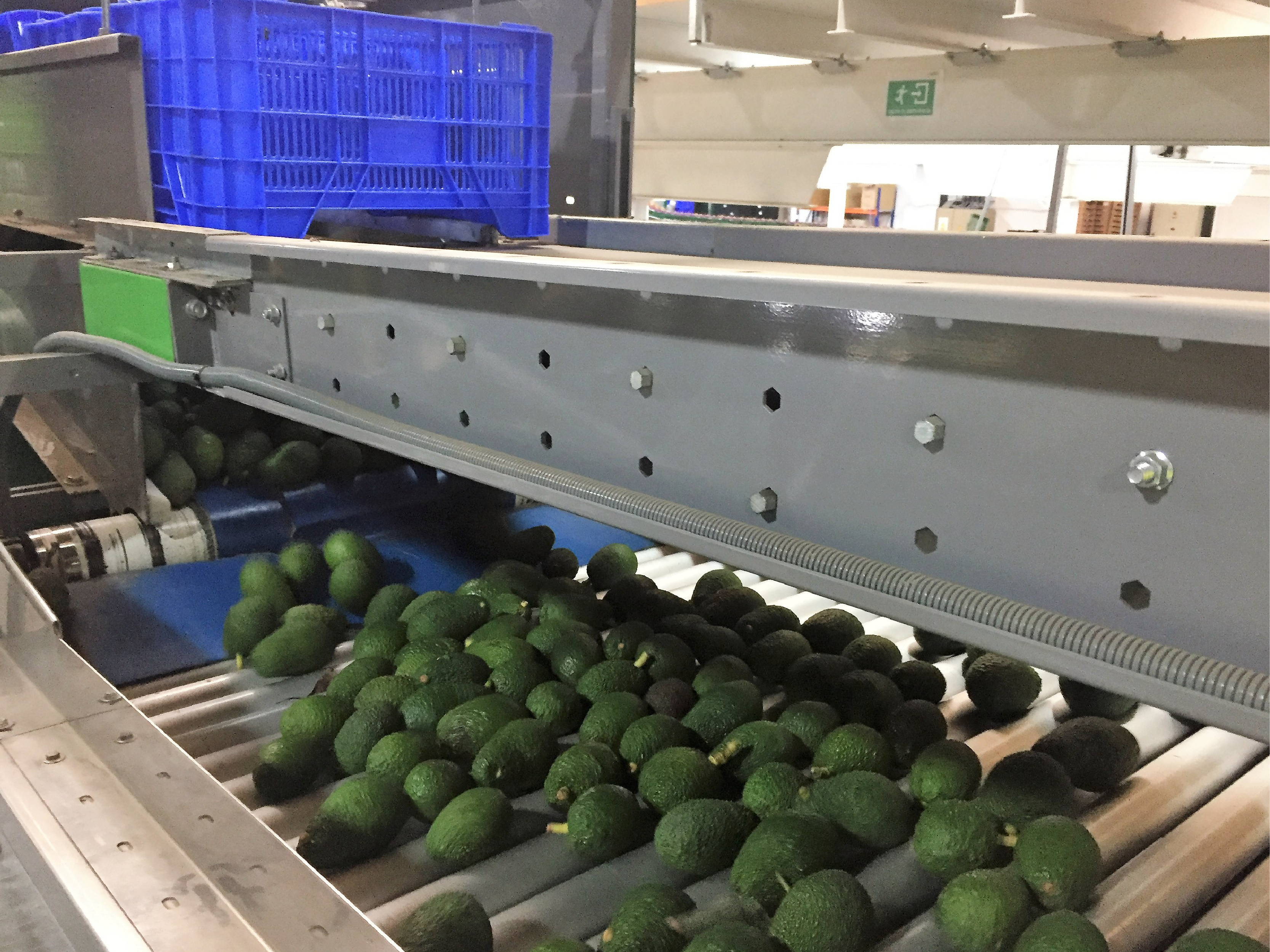
Packhouse practices cover the activities from the moment the products arrive in the packhouse to the moment of transport/export to the intended market. Sorting, grading, packing and cooling are among the main activities. For avocado as well as for many other fruit, it is very important that the packhouse has sufficient capacity to cool down the products; as good temperature management is a requirement to maintain a good quality of horticultural produce. Furthermore, proper cleaning and sanitizing of building and equipment is part of good packhouse practices
Processing Avocados in the Packhouse
The processing of avocados at the packhouse facility must be well regulated and controlled. The process of sizing and grading is usually carried out through an automated system, such as roller conveyors with adjustable speed, but always well supervised. Cooling of the products should follow immediately. Forced air cooling is an effective tool to quickly lower the fruit temperature. However, avocados should not be stored below their critical temperature, as chilling injury may then occur which would result in risks on discolourations of skin and flesh and poor flavour.
Activities In the Avocado Packhouse Before Packing
Receipt and Unloading
When avocados arrive from the orchard, unloading should begin as soon as possible in order not to delay further processing and the beginning of cooling. In the case that the fruit needs to wait for several hours (overnight), a small cold store facility is advisable (cold storage at 10° to 15°C). Weight of crates of fruits is recorded. A first quality control can take place simultaneously with unloading. A quality supervisor registers the data of the product such as color, size, spots and defects. The stacking of the products received at the facility is done orchard-wise and clearly identifiable to maintain traceability.
Grading
The process of grading and classification should result in uniformity in origin, variety or commercial type, size and quality. The first step is to remove unmarketable fruits if this wasn’t done yet at the orchard. Any decay, physical injuries, defects caused by insects or rodents, misshapen or immature fruit should be removed. Always handle fruit carefully during this grading process.
Classification
Avocados are classified into classes such as: class Extra, Class I and Class II. Minimum requirements for all classes are that fruits must be intact, free from rot or deterioration, clean, free from any foreign visible matter, no damage caused by pests or low temperatures, not too long stalk, no external moisture and no strange smell or taste. Moreover, the condition of the avocado must be such that it can withstand transportation and handling to arrive satisfactory at the place of destination.
Sizing
The goal of sizing is to ensure uniformity in size within the same package. It is preferred to use sizing machine for this process. Automatic sizing increase capacity and enables easier registration of sorting results. Avocados below a certain minimum weight (for example 100 g) may not be suitable for the intended market
Activities in avocado packhouse from packing onwards
Packing
The packaging needs to provide physical protection to the fruit. Therefore, a strong protective packaging is used. Typically cardboard packaging material is used. The material should keep its strength in the whole cold chain, and therefore requires sufficient moisture resistance. Cardboard boxes must be packed based on weight, ripeness and classification of the avocados. Packaging requirements vary between customers and market segments, but usually the packaging is in single-layer boxes. Packing with similar sizes in one box on one layer helps to avoid vibration injury during transit. The common varieties are often traded in 4 kg cardboard boxes for European market. For lower quality class or other markets, plastic tray of 10 kg may be used.
Labeling and palletizing
Filled cartons must be stacked on a pallet (e.g. 200 cartons of 4 kg) and labelled with information including packhouse code, size/class, and batch number. Further the name of the fruit (avocado) + variety, net weight and time of packing must be on each box label. The exact requirements can differ depending on local regulations and client demands. The completed pallets must be strapped well in such a way that the packaging cannot shift or fall. Often cardboard edge protectors are used to stabilize pallets. As soon as pallets are completed, they need to be moved to the cold storage.
Pre-cooling before storage or shipment
A fast temperature reduction is necessary to remove field heat as soon as possible. The process between moment of harvest and sorting / packing should be time efficient to minimize time at sub-optimal temperature and to cool down to T optimal before shipment as soon as possible. Avocados should be cooled soon after harvest when their temperature is above the recommended cold storage temperature (~ 6 °C dependent on variety). Forced-air cooling is an effective tool to quickly bring down the fruit temperature to 8-10 °C within a period of several hours and can then be transferred to the cold room (~ 6 °C dependent on variety). During this pre-cooling process, the fruit temperature should be checked regularly in the interior of the boxes, at the coldest and warmest spot of the pallet.
Storage
The optimal storage temperature for avocados depends on various factors such as cultivar, maturity stage and storage time. Avocados should not be stored below their critical temperature, as chilling injury can occur that would result to risks of various quality problems, such as uneven ripening, increased susceptibility to decay and, flesh browning and poor flavour. Therefore, regularly check the temperature and quality in the storage room. ‘Hass’ avocados can generally be stored a little colder (5°C) than other cultivars). It is also possible to apply a 1-MCP treatment to delay ripening. A high relative humidity (85-90%) can further help to maintain quality.